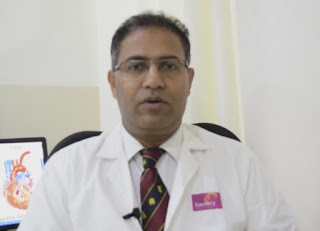Palpitations are a rapid, strong and irregular heartbeat due
to some kind of illness or excess agitation or overexertion of the muscles.
Palpitation is associated with anxiety and does not necessarily indicate any
abnormality of the heart, but it can be a symptom arising from an irregular
heartbeat. The anxiety might be caused due to excess consumption of caffeine or
nicotine or alcohol. Sometimes palpitations could occur during pregnancy.
Palpitation can be intermittent and of different intensity and duration, or
continuous. Generally, palpitations are not serious or harmful and usually go
away on their own.
What causes palpitations?
Palpitations are mainly associated with the following
• Coronary
heart diseases, congestive heart failure, heart valve problems.
• Thyroid
problems such as hyperthyroidism.
• Low blood
pressure, fever.
• During
pregnancy if the mother has anemia or hormonal changes.
Some people experience palpitations after eating heavy meals
composed of a lot of carbohydrates, sugar, or fat. Monosodium Glutamate (MSG)
present in certain foods can also trigger palpitations.
Wonder what happens to the heart during palpitations?
During palpitation the upper chamber of the heart, the
arteries contract prematurely. In order to compensate this, the arteries rest
for a fraction of a second longer than usual and this is followed by the
forceful contraction of the lower chambers of the heart (the ventricles).
Sometimes the lower chambers of the heart contract
prematurely and if this keeps continuing for every beat then it leads to a
condition called ventricular fibrillation. Ventricular fibrillation requires
immediate medical attention because it is the most frequent cause of cardiac
arrest.
Here are the symptoms associated with palpitations.
• The person
might begin to feel slightly dizzy or light headed.
• The
person could experience difficulty in breathing properly.
• Sometimes
the person might faint and lose consciousness.
• Excessive
sweating accompanied by pain and pressure in the chest can also be felt.
Medical treatment is required as soon as possible if the
condition becomes serious.
How do you control palpitations?
In many cases, palpitations are harmless and go away on
their own. Generally, if there are no underlying conditions like a heart disease
then the following might prove very
effective:
• Keep your
alcohol, nicotine and caffeine levels under control.
• Stress
and anxiety are a major cause so focus on doing more yoga and relaxing
exercises. Take a peaceful walk on the beach and focus on keeping serene.
• If you
have allergies that make you cough, avoid those substances at all cost.
These are very
general methods to avoid palpitations, but for more specific conditions like
anemia or heart disease, more focus should be given to eliminate the underlying
disease.
So, once you’ve found the problem and treated it, make sure
you follow the correct lifestyle to keep palpitations at bay and safeguard your
ever pumping heart from danger.






































